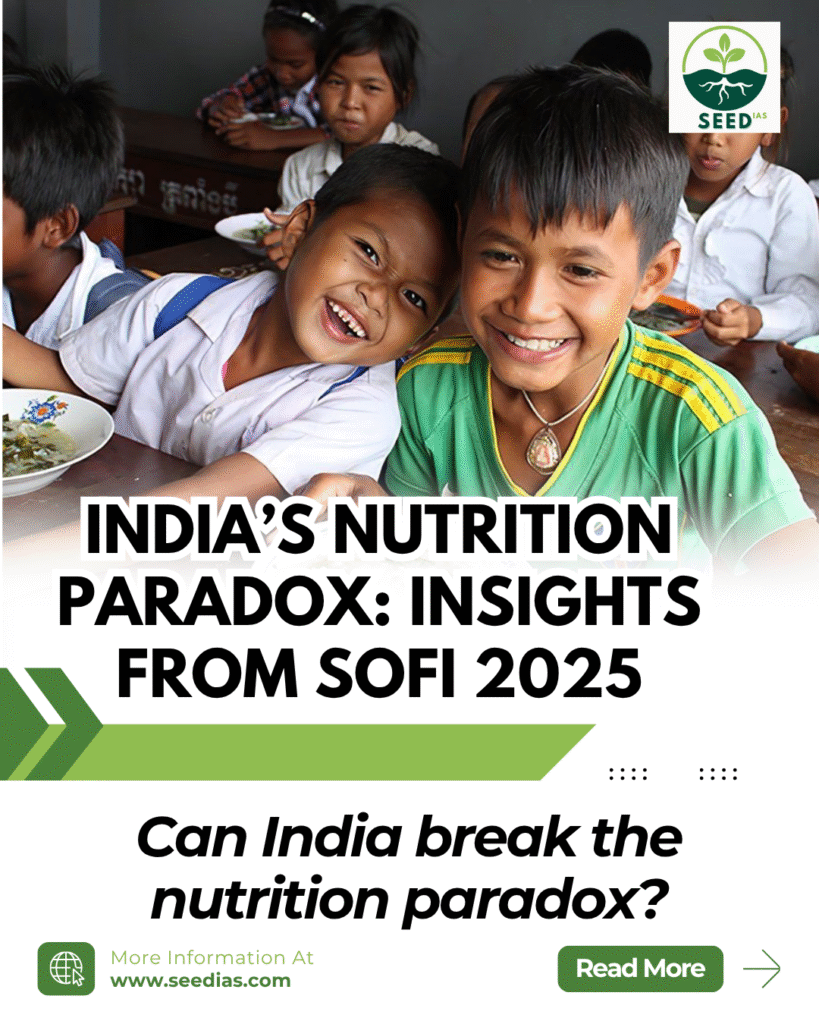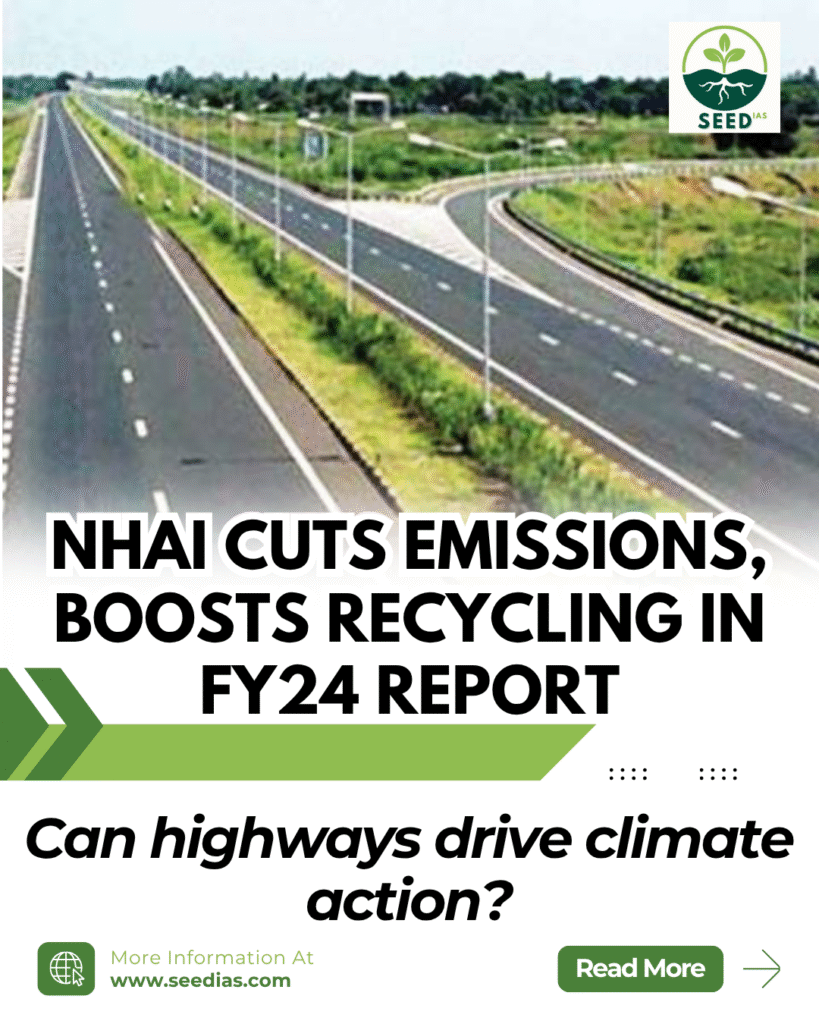Why in NEWS
The State of Food Security and Nutrition in the World (SOFI) 2025 report shows that while global hunger has declined to 673 million people, India still has the highest number of wasted children under five.
Key Terms and Concepts
| Term | Explanation |
|---|---|
| SOFI Report | Annual global hunger and nutrition assessment published jointly by FAO, IFAD, UNICEF, WFP, and WHO |
| Undernourishment | People whose food intake fails to meet minimum dietary energy requirements |
| Food Insecurity | Inability to consistently access nutritious and sufficient food |
| Wasting | Low weight-for-height; indicator of acute undernutrition |
| Stunting | Low height-for-age; indicator of chronic undernutrition |
| Hidden Hunger | Micronutrient deficiencies despite adequate calorie intake |
| Double Burden | Co-existence of undernutrition and overnutrition (obesity) |
Current Global and Indian Scenario
Global Hunger and Food Insecurity (2024)
- 673 million people (8.2%) were hungry (down from 8.5% in 2023), but still above pre-COVID levels
- 2.3 billion people face moderate/severe food insecurity
- 2.6 billion people cannot afford a healthy diet (improved from 2.76 billion in 2019)
- Asia (323 million) and Africa (307 million) lead in undernourishment
India’s Nutritional Snapshot (2024)
- Undernourished: 172 million people (12% of population)
- Healthy diet unaffordability: 42.9%; food cost rose to USD 4.07 PPP (from USD 2.77 in 2017)
- Wasting: 18.7% (highest globally), affecting over 21 million children
- Stunting: 37.4 million children under five
- Overweight children: Rose from 2.7 million (2012) to 4.2 million
- Obese adults: Doubled from 33.6 million to 71.4 million
- Anaemic women (15–49 yrs): 203 million (53.7%); India ranks 4th globally
Malnutrition Indicators in Children
| Indicator | Definition | Consequences |
|---|---|---|
| Stunting | Height-for-age < -2 SD | Poor cognitive development, low school performance |
| Wasting | Weight-for-height < -2 SD | Immunity loss, severe illness risk |
| Overweight | Weight-for-height > +2 SD | Risk of NCDs (diabetes, cardiovascular diseases) |
| Underweight | Weight-for-age < -2 SD | Growth delays, higher mortality risk |
Causes of India’s Nutrition Paradox
- Persistent Poverty: Affects rural, tribal and marginalized groups
- Dietary Monotony: Lack of protein, fruits, and vegetables despite calorie sufficiency
- Rising Food Prices: Nutrient-rich food inflation limits affordability
- Healthcare Gaps: Poor access to nutrition counselling, anaemia treatment
- Nutrition Transition: More processed food, urban obesity on rise
Government Schemes for Nutrition and Food Security
| Scheme | Description |
|---|---|
| Public Distribution System (PDS) | Automated FPSs cover 80+ crore people ensuring foodgrain delivery |
| PM POSHAN (Midday Meal) | Nutritional support for school children |
| PMGKAY (2020–2029) | Free 5 kg foodgrains/month for 81 crore beneficiaries |
| POSHAN Abhiyaan | Addresses malnutrition in women and children (10 crore+ beneficiaries) |
| PMFME Scheme | Promotes local food processing units; 54,000+ units set up |
| Price Stabilization Fund | Controls prices of essentials like rice, onions, dal |
Strategic Recommendations
- Strengthen Local Food Systems: Support FPOs, reduce price volatility via agri-market intelligence
- Improve Diet Diversity: Promote region-specific crops, kitchen gardens, and millet consumption
- Tackle Anaemia: Scale-up Anaemia Mukt Bharat with tailored iron and folic acid therapy
- Enhance Midday Meals: Include eggs and dairy regularly
- Boost PM POSHAN & POSHAN Abhiyaan: Address both macro- and micronutrient deficiencies
- Ensure Portability: Expand ‘One Nation, One Ration Card’ for migrants
- Control Overnutrition: Launch ‘Suposhan Abhiyan’, tax junk food, and subsidize healthy items
- Education & Awareness: Include nutrition curriculum in schools using sugar boards
In a Nutshell
Memory Code: WASTED-ACT
W – Wasting rate highest globally
A – Anaemia in over half of women
S – Stunting among 37 million children
T – Transition to processed foods
E – Eggs and dairy missing in diets
D – Double burden: under and overnutrition
A – Affordability crisis for healthy food
C – Chronic hunger despite economic growth
T – Targeted schemes need better convergence
Prelims Practice Questions
- Which of the following organizations does not contribute to the SOFI report?
A. FAO
B. WFP
C. WHO
D. UNDP - What is the correct definition of ‘wasting’ as per WHO standards?
A. Weight-for-age < -2 SD
B. Height-for-age < -2 SD
C. Weight-for-height < -2 SD
D. BMI < 18.5 - Which of the following correctly explains India’s nutrition paradox?
A. High caloric consumption with no food insecurity
B. High obesity with no malnutrition
C. Coexistence of undernutrition and rising obesity
D. Only rural areas face undernutrition
Mains Practice Questions
- “India’s nutritional paradox reflects deeper socio-economic inequities.” Critically examine. (15 marks)
- What are the key findings of the SOFI 2025 report regarding food security and nutrition in India? Discuss the way forward. (15 marks)
Prelims Answer Key and Explanation
| Qn | Ans | Explanation |
|---|---|---|
| 1 | D | UNDP is not part of SOFI; the report is published by FAO, IFAD, UNICEF, WFP, WHO |
| 2 | C | Wasting is defined as weight-for-height < -2 SD |
| 3 | C | India faces both undernutrition (wasting, stunting) and rising obesity, forming a nutritional paradox |
















